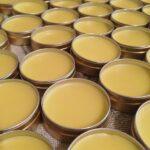- Comfrey – The Unsung Hero of the Homestead
- What is Comfrey? A Resilient Ally for Your Land
- Choosing Your Comfrey: Bocking Varieties for Purposeful Growth
- Multiplying Your Homestead's Asset: Propagating Comfrey from Roots
- Comfrey in the Garden: A Gardener's Secret Weapon
- Comfrey for Livestock: A Nutritional Boost for Your Flocks & Herds
- Comfrey as Your Home Apothecary: Healing from the Earth
- Growing Comfrey in the Deep South: A Homesteading Advantage
- Embrace Comfrey – Cultivate a More Resilient Homestead
Comfrey – The Unsung Hero of the Homestead
On a bustling homestead, every plant earns its keep. While our chickens might eagerly gobble up its lush leaves, limiting comfrey’s role to mere fowl fodder is like judging a thoroughbred by its ability to pull a plow.
This remarkable herb, often affectionately called “knitbone,” is a veritable powerhouse, offering an astonishing array of benefits for your garden, your livestock, and even your family’s external well-being. From enriching your soil and feeding your animals to becoming a cornerstone of your home apothecary, comfrey (Symphytum spp.) holds a prized position in your sustainable living toolkit.
Here at Dixie Living Homestead, we’ve come to rely on comfrey as a versatile ally, a testament to nature’s incredible provisions. In this comprehensive guide, we’ll peel back the layers of this fascinating plant, exploring its diverse uses, ideal varieties for homesteaders, easy propagation methods, and how you can harness its legendary properties to cultivate a more resilient and self-sufficient lifestyle.
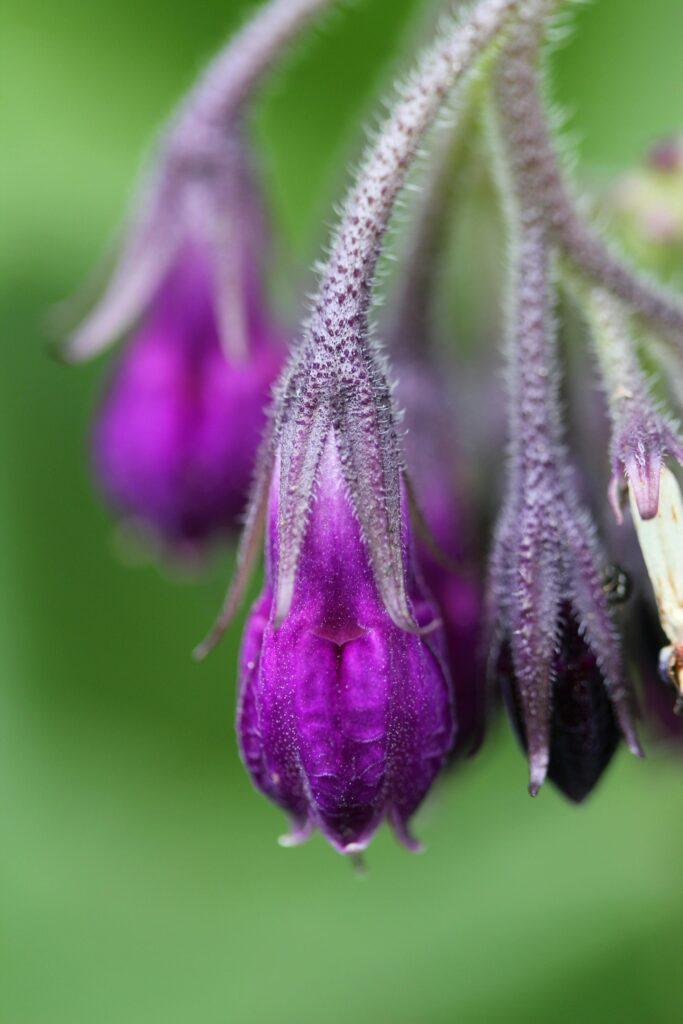
What is Comfrey? A Resilient Ally for Your Land
Comfrey is a vigorous, deep-rooted perennial herb belonging to the Boraginaceae family. (YES, you did see the word “borage” in there). Characterized by its large, hairy leaves and bell-shaped flowers (often purple, blue, or white), it’s a remarkably hardy plant that thrives in a variety of climates, often growing to several feet tall. Its extensive root system can delve deep into the earth, drawing up nutrients from subsoil layers that are unavailable to shallower-rooted plants.
A Brief History of “Knitbone”: Comfrey’s reputation as a healing herb stretches back centuries. Its common name, “knitbone,” speaks volumes about its traditional use for mending fractures, sprains, and bruises.
The plant contains allantoin, a compound believed to promote cell proliferation and regeneration, historically making it a go-to remedy for external wounds and bone injuries. While modern science has shed light on both its benefits and cautions, its historical significance as a powerful natural healer remains undisputed.
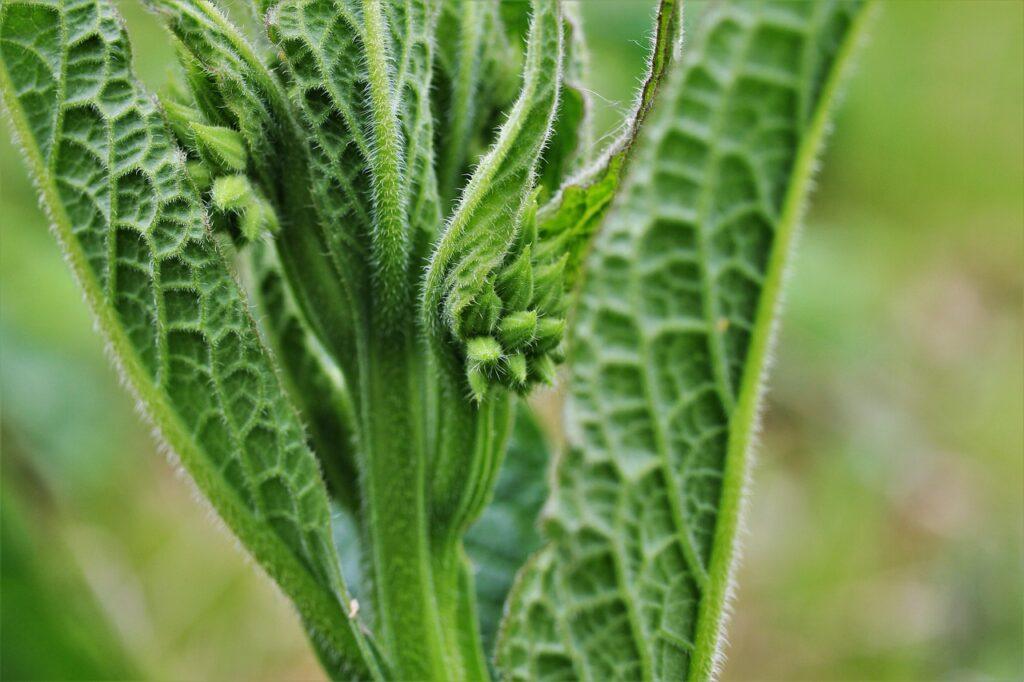
Choosing Your Comfrey: Bocking Varieties for Purposeful Growth
For homesteaders, not all comfrey is created equal. While common comfrey (Symphytum officinale) exists, the preferred varieties for cultivation are the sterile hybrids, primarily ‘Bocking 4’ and ‘Bocking 14’. These varieties are a cross between common comfrey and prickly comfrey (Symphytum asperum).
Being sterile, they do not produce viable seeds, which is a massive advantage as it prevents them from spreading invasively throughout your garden, ensuring they stay where you plant them. Propagation is solely through root division.
- Bocking 4: The Protein Powerhouse: This variety is particularly noted for its high protein content, making it an excellent choice for animal fodder. If your primary goal is to supplement your livestock’s diet with nutrient-rich greens, Bocking 4 is a superb option. It’s often recommended for chickens, pigs, and other animals due to its digestible protein. Our dairy goats love their prickly leaves!
- Bocking 14: The Medicinal & Mineral Maestro: While also a good fodder plant, Bocking 14 is highly prized for its higher concentration of allantoin and its reputation as a dynamic accumulator of minerals like potassium. This makes it the preferred choice for gardeners looking to create nutrient-rich compost and liquid fertilizers, and for those aiming to craft healing salves and poultices. Once you get past the smell, comfrey tea will become your new garden BFF.
- Why Non-Seeding Varieties Matter: The sterile nature of Bocking 4 and Bocking 14 is a gardener’s dream. Unlike common comfrey, which can reseed aggressively, these hybrids will stay put, expanding only through their root systems. This means you can plant them in dedicated beds without fear of them taking over your entire property, a critical consideration for thoughtful homestead design.
Multiplying Your Homestead’s Asset: Propagating Comfrey from Roots
One of the most appealing aspects of comfrey is how incredibly easy it is to multiply. Once you have a single healthy plant (or a few root cuttings), you can rapidly expand your comfrey patch, transforming a small investment into a lifetime supply. This is done primarily through root cuttings.
Here is a brief video from our homestead in Florida demonstrating how easily the root cuttings become a vigorous plant.
- The Art of Root Cuttings: The best time to take root cuttings is in the dormant season – late fall after the plant dies back, or very early spring before new growth emerges.
- Carefully dig around an established comfrey plant. Its roots are thick and black.
- Locate some healthy root sections, about the thickness of your finger.
- Cut pieces that are 1-2 inches long. Each piece should ideally have an “eye” or bud, but comfrey is so vigorous that even plain root sections often sprout.
- Planting and Care for New Cuttings:
- Plant these root cuttings horizontally, about 2-3 inches deep, in well-drained soil in a sunny to partially shaded location.
- Ensure the soil remains consistently moist but not waterlogged.
- Comfrey is a resilient plant. Even small root fragments can sprout, so handle them carefully to avoid unwanted spread in areas where you don’t desire comfrey.
- Within a few weeks to a couple of months, you should see new shoots emerging, ready to establish your growing comfrey patch.
Comfrey in the Garden: A Gardener’s Secret Weapon
Beyond its direct benefits to animals, comfrey is an invaluable asset to me as a gardener utilizing organic practices, significantly improving soil health and plant vitality.
- The Dynamic Accumulator: Feeding Your Soil: As a dynamic accumulator, comfrey draws up essential nutrients (especially potassium, phosphorus, calcium, and trace minerals) from deep within the soil profile, making them available in its leaves. When these leaves decompose, they release these nutrients into the topsoil, benefiting shallow-rooted plants.
- Crafting Comfrey Tea (Liquid Fertilizer): A Potent Brew: This is one of the most popular uses for comfrey in the garden.
- Method 1 (Simple Soak): Pack a bucket tightly with comfrey leaves (no stems). Fill with water. Cover (it will get stinky!) and let it steep for 2-4 weeks.
- Method 2 (Concentrate): Pack leaves tightly into a bucket with a spigot at the bottom. Weigh them down. As they break down, a dark, potent concentrate will leach out.
- Usage: Dilute comfrey tea at a ratio of 1:10 (1 part tea to 10 parts water) before applying to plants. It’s particularly beneficial for fruiting and flowering plants due to its high potassium content.
- Chop-and-Drop Mulch: Suppressing Weeds, Enriching Soil: We simply chop comfrey leaves and lay them directly around the base of other plants, fruit trees, or in our garden beds. As the leaves break down, they provide a slow-release fertilizer, suppress weeds, conserve soil moisture, and feed beneficial soil microbes.
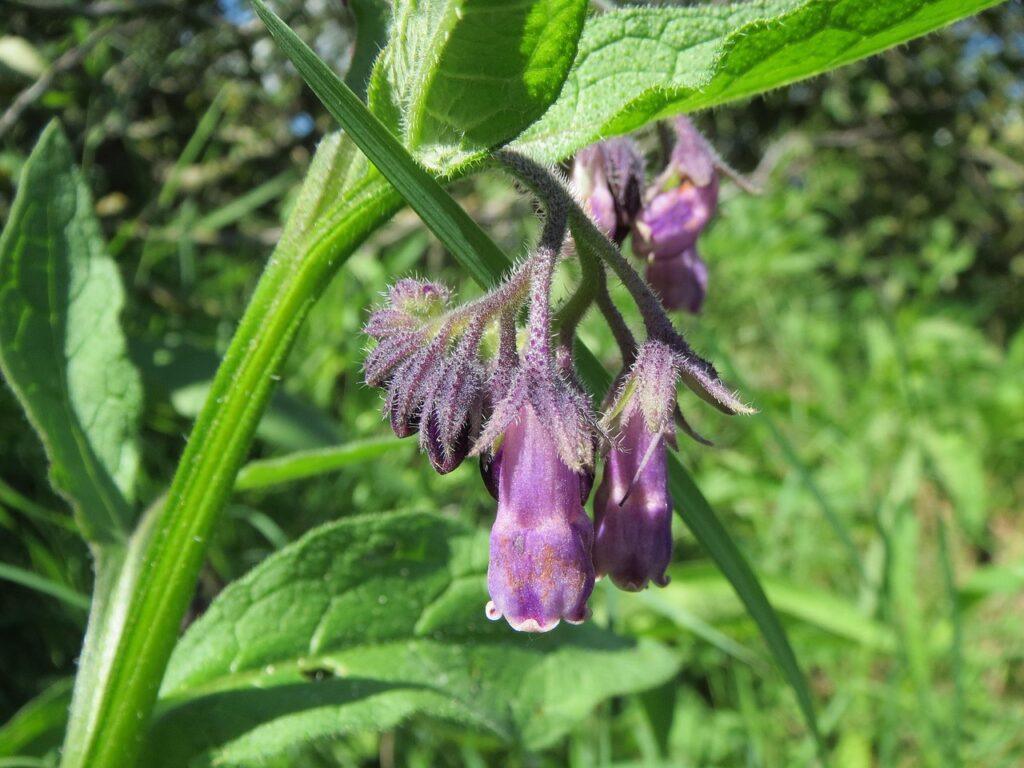
Comfrey for Livestock: A Nutritional Boost for Your Flocks & Herds
While we’ve touched on it, let’s explore comfrey’s value as a superfood for various homestead animals. Its digestibility, high protein content (especially Bocking 4), and rich mineral profile make it an excellent dietary supplement.
- Chickens: More Than Just a Snack: Yes, chickens love comfrey! It’s not just “fodder” but a nutritious supplement. The leaves provide protein, vitamins (A, B12), and minerals, supporting overall health and vibrant egg yolks. Offer it fresh, chopped, or wilted. If you let it dry you can crumble it easily into their dry or fermented feed.
- Sheep & Goats: Digestible Greens and Milk Production Support: Comfrey is particularly beneficial for ruminants. It can aid digestion, and many homesteaders report improved milk production and healthier coats when regularly feeding comfrey to lactating ewes and does. It acts as a natural “concentrate,” providing essential nutrients that might be lacking in poorer pasture.
- How to Incorporate Comfrey into Animal Diets:
- Fresh: Offer fresh, chopped leaves to your animals. They may need a few “trial feeds” to get accustomed to it.
- Wilted: Some animals prefer slightly wilted leaves. Our goats like it wilted and the rabbits prefer it fresh.
- Hay/Silage: In larger operations, comfrey can even be harvested and dried for hay or ensiled, allowing for winter feeding.
- Moderation is Key: As with any supplement, offer comfrey in moderation as part of a balanced diet. Most animals are intelligent enough to self-regulate so there’s no need to be overly concerned.
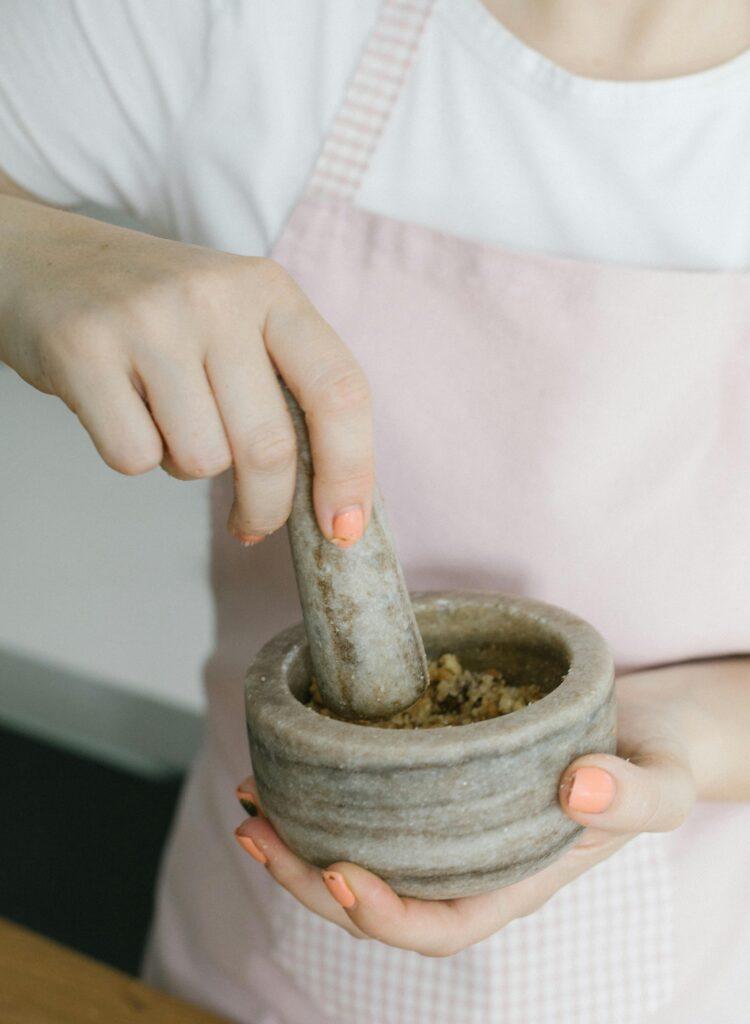
Comfrey as Your Home Apothecary: Healing from the Earth
This is where comfrey truly shines as “knitbone.” Its topical applications for skin health, minor injuries, and musculoskeletal issues are legendary.
- Crucial Safety Note: The Importance of External Use ONLY: It is critical to understand that comfrey contains pyrrolizidine alkaloids (PAs), which can be toxic to the liver if ingested in excessive amounts internally. For this reason, comfrey should only be used externally on unbroken skin.
- Do NOT consume comfrey tea or other internal preparations. Always consult with a healthcare professional before using any herbal remedies, especially if you have underlying health conditions, are pregnant or breastfeeding, or are taking medications. Your safety is paramount. I am NOT a doctor.
- Comfrey Salve: Your Go-To for Bruises, Sprains, and Skin Health: A homemade comfrey salve is an indispensable item for your natural first-aid kit. It’s wonderfully soothing and promotes healing for:
- Bruises
- Sprains and strains
- Minor cuts and scrapes (on unbroken skin)
- Dry, irritated skin
- Sore muscles and joints, can I just say AWESOME!
- Making Your Own Comfrey-Infused Oil: This is the base for your salve.
- Gather fresh or dried comfrey leaves (and/or roots, which are more potent for salves).
- Chop them finely.
- Place the comfrey into a clean, dry glass jar.
- Cover completely with a carrier oil like olive oil, almond oil, or coconut oil, ensuring no plant material is exposed to air.
- Solar Infusion: Cap tightly and place in a sunny window for 2-4 weeks, shaking daily.
- Gentle Heat Infusion: Alternatively, use a double boiler or slow cooker on low heat for 4-6 hours to speed up the process. I love this option when I have run out and have an immediate need.
- Strain the oil thoroughly through cheesecloth, squeezing out every last drop.
- Crafting the Salve:
- For every cup of infused comfrey oil, you’ll need about 1/4 cup of beeswax pellets (adjust for desired firmness).
- Gently melt the beeswax in a double boiler.
- Once melted, slowly add the comfrey-infused oil, stirring until fully combined.
- Pour the warm mixture into clean tins or jars. Let cool completely before capping.
- Comfrey Poultices: Direct Healing for Deeper Needs: For more intense or localized issues, a fresh comfrey poultice can be highly effective.
- Preparation: Harvest fresh comfrey leaves. Gently bruise or macerate them (e.g., with a mortar and pestle, or finely chop them) to release their juices. You can also add a little water to form a paste.
- Application: Apply the bruised leaves directly to the affected area (e.g., a sprained ankle, a deep bruise, or swollen joint – always on unbroken skin). Cover with a bandage or cloth to hold it in place.
- Frequency: Change the poultice every few hours or once it dries out.
- Note: While historically used for fractures, for any suspected bone injury, always seek professional medical attention first. Comfrey can aid in healing after proper alignment and medical assessment.
Homemade Comfrey Salve
Equipment
- Immersion blender
Materials
- 1 Cup Infused Comfrey Oil See notes in post
- 1/4 Cup Organic Beeswax Pellets
Instructions
- Gently melt the beeswax in a double boiler.
- Once completely melted, slowly add the comfrey-infused oil using an immersion blender to combine.
- Carefully pour the warm mixture into clean tins or jars.
- Allow to cool completely before capping.
Growing Comfrey in the Deep South: A Homesteading Advantage
Comfrey thrives in the warm, humid climate of the deep South where our homestead is located, often growing year-round with minimal fuss once established. While most information says “grow in full sun” that does not mean our full sun. The leaves will burn and die back in the summer heat here if you do not put comfrey in a place with some protection from the brutal heat of the day.
- Site Selection and Care:
- Sun: Prefers full sun to partial shade. In the intense Southern summer, a bit of afternoon shade can be beneficial.
- Soil: Adaptable but prefers well-drained, fertile soil. It tolerates heavier clay soils well due to its deep roots.
- Water: Needs consistent moisture, especially when establishing, but is fairly drought-tolerant once mature.
- Planting: Plant root cuttings directly in the ground, spacing them about 2-3 feet apart as they grow quite large. If you decide to start them in pots you will need to move them out fairly quickly once established as comfrey’s deep taproot needs room to thrive.
- Harvesting Your Abundance: Comfrey is a “cut-and-come-again” plant. You can harvest the leaves multiple times throughout the growing season, typically every 4-6 weeks once the plant is established. Simply cut the leaves a few inches above the ground.
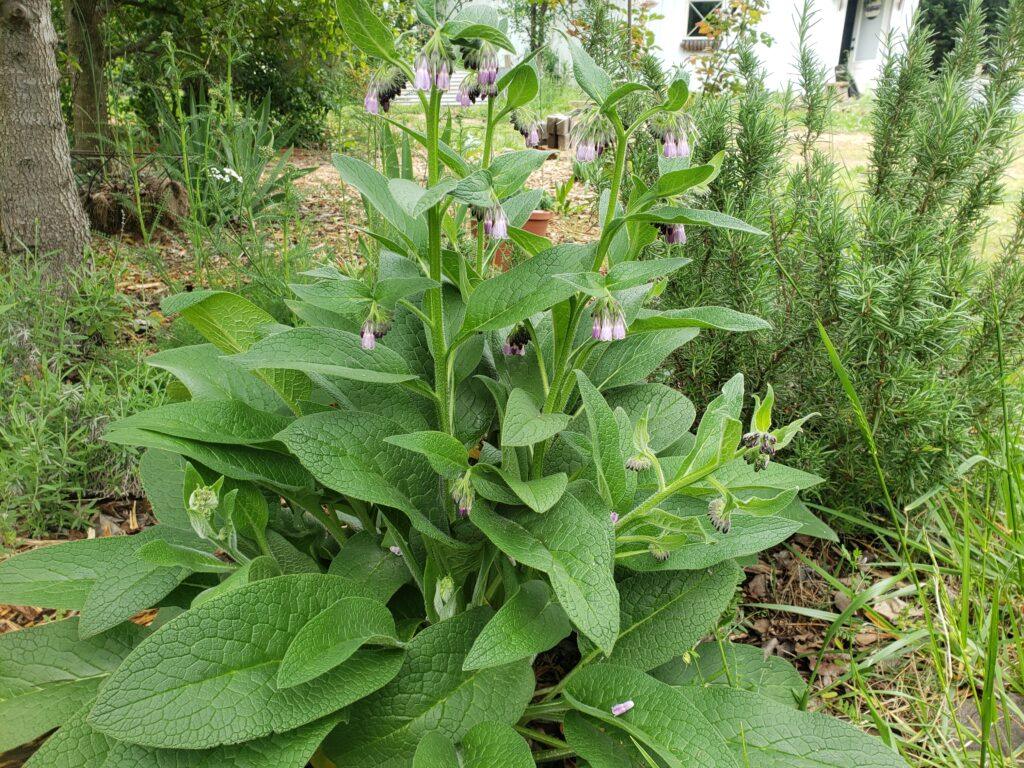
Embrace Comfrey – Cultivate a More Resilient Homestead
Comfrey truly is one of the most versatile and valuable plants a homesteader can cultivate. Far from being just “chicken fodder,” it’s a dynamic contributor to soil health, a nutritious supplement for diverse livestock, and a potent ingredient for your natural home apothecary.
By understanding its unique properties and incorporating it thoughtfully into your homestead practices, you’re not just growing a plant; you’re cultivating resilience, fostering natural well-being, and taking another meaningful step towards a truly self-sufficient life.
What are your favorite ways to use comfrey on your homestead? Have you found unique applications for this amazing plant? Share your experiences and tips in the comments below – let’s learn and grow together as a community of mindful homesteaders!

